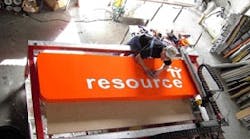Readers of this site understand Computer Numerical Control (CNC) technology, but anyone who has not heard of it before will know about it soon, considering the widespread acceptance of this foundational tool used by tech-savvy manufacturers. CNC allows machines to be guided by easy-to-use applications, using controls that integrate seamlessly in a personal computer. A typical CNC machine is used for cutting, milling, drilling, and routing of almost any material, for any reason, and it can be used for any project that requires accurate, repeatable, and efficient mechanical movements for extended periods of time.
The only limits to CNC capability are the users’ imaginations and programming abilities. So, as more users adopt the technology, it becomes increasingly useful even for inexperienced users — and that acceptance continues to drive its evolution. How will the evolution of CNC impact the way we live and work?
Any time industrial equipment or technology migrates from exclusive use by industry giants into the hands of independent users, it evolves in unusual ways. Ten years ago, you could find regular use of CNC machines and other types of automation by government contractors and high-end fab shops and factories around the world. It was similar to the military complex’s initial use of the Internet. Yet, once the technology hit personal computers, its uses and capabilities seemed to be unlimited. When the people of the world take hold of new technology, they squeeze out of it every imaginable application, and end up changing the world as we know it.
Soon, we will see CNC technology evolve just as the Internet has done, and continues to do. It has expanded into the hands of millions of people and gives them the ability to do things that we might have only seen in science fiction movies. As the cost of CNC technology drops, we see a variety of uses that the original designers of the technology did not envision. Small companies are able to tinker with technology that would have been too cost-prohibitive five years ago. As people ‘play’ with this technology, an evolved form of CNC not only will increase the speed at which individuals personally manufacture objects, but it also will give rise to a world of convenience, efficiency, and precision for automated processes of projects previously done by hand.
Here are my predications for uses of CNC that will emerge in the next ten years. I don’t guarantee these ideas will come true, but they will help you to understand the potential of this technology and the significance of its impact on our future.
3D Printing allows instant creation of practically anything. Three-dimensional printing using resins, plastics, and even metal alloys is emerging from small shops around the world, and while it’s still in its infancy these technologies are paving the way to new businesses, and changing industries. Today, we are seeing the early stages of this with on-demand 3D printing: ordinary people can have objects created for them simply be sending a company a computer file, and this is just the tip of the iceberg. Recently, a few companies have shown that nylon printing can create articles of clothing; ten years from now we may simply be printing the clothes we wear.
Precision mechanics for everyday convenience. CNC applications will not necessarily create new objects but rather automate processes that once had been done by hand. CNC paint sprayers, or etching devices that can be moved with more precision that any human can achieve. Industries have sprung up around these applications. It is now possible to draw a design with a pen and paper and have it etched or painted on a laptop, or cut from vinyl to stick on the window of your car. These technologies are coming to the home, too. In the last few years CNC has been adopted by cake decorators (designing with icing) and egg printers (using food-safe inks to create works of art on egg shells) at costs that make customized processes available every day. This technology will establish the ability to automate and mechanically control the most basic of tasks, including (but not limited to) preparing meals, cleaning the house, and styling hair, all with a simple push of a button.
Fully mobile CNC machines for used by the public. Like the Internet, CNC technology will continue to evolve to a point of full mobility. Already there are affordable home CNC machines that can cut metal, wood, and plastics, fit on a tabletop, and can be moved around by one person. Soon, you will be able to carry a CNC machine in your pocket for writing or drawing as well as tackling massive projects, with thousands of them working in concert, like ants. We see this concept in place in fully automated factories and, like basic CNC, it won’t be long before this technology makes it to the everyday user. Creating or doing anything mechanical, on-the-go, will become easier and more efficient. It is probably safe to assume that mobile CNC machines will be able to make other CNC machines that can perform completely different tasks.
Considering these predications will help anybody to understand the possibilities of this amazing, emerging technology. The evolution of CNC capabilities eventually will bring us into a world of instantaneous object creation and service robotics that will change forever how we think and feel about mechanical labor in our daily lives. As these machines develop, being on the cutting edge will be more important than ever and will determine the leaders of the industries of the future.
Jack Douglass is the technical support manager for Torchmate CNC Cutting Systems, a Lincoln Electric company that manufactures CNC and metal-cutting machinery of all sizes, ranging from the Torchmate X for shipbuilding to the recently released 2X2 system. Contact him by email, or tel. 866-571-1066.






